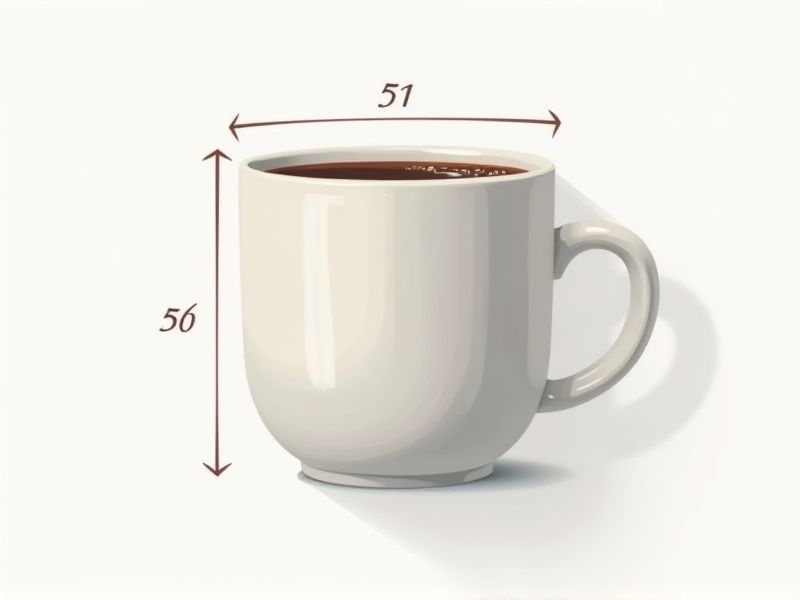
When selecting a standard mug, most people look for a capacity between 10 to 12 ounces, which suits everyday hot beverages like coffee or tea. The typical mug stands around 3.5 to 4 inches tall and has a diameter of about 3 inches at the rim. These dimensions are comfortable to hold and fit well under most home coffee machines. Choosing a mug in this size range ensures practicality and compatibility for most kitchen needs.
Volume Capacity
The standard volume capacity of a typical mug ranges from 8 to 12 ounces, making it ideal for various hot and cold beverages. For specialty mugs, such as those used in cafes, the volume can extend to 14 ounces or even 16 ounces to accommodate larger servings. When selecting a mug, consider how much liquid you typically consume at one time, as this can enhance your drinking experience. Keeping in mind the volume, choose a mug that suits your daily beverage needs and personal preferences.
Height Of The Mug
A standard mug typically measures between 3.5 to 4.5 inches in height, providing a comfortable grip for daily beverages. Many mugs have a volume capacity ranging from 8 to 12 ounces, making them ideal for coffee, tea, or cocoa. If you prefer larger servings, consider mugs that can hold up to 16 ounces, which are often used for lattes or larger drinks. Your choice of height can also affect storage, as taller mugs may not fit easily in standard kitchen cabinets.
Width Or Diameter
When selecting a mug, the standard measurement for width typically ranges from 3 to 4 inches in diameter. A wider mug, approximately 4 inches, holds more liquid, accommodating around 12 to 16 ounces. Opting for a narrower diameter can enhance your grip, making it easier to handle during use. Understanding these dimensions allows you to choose a mug that suits your personal needs, whether you prefer a larger capacity or a more ergonomic design.
Handle Size
The standard handle size for a mug typically ranges between 3 to 4 inches in length, designed to accommodate the average adult hand comfortably. A diameter of about 1 to 1.5 inches ensures a secure grip while preventing fingers from touching the hot ceramic. For optimal usability, the handle should be positioned approximately 2 inches above the mug's body, allowing for easy lifting and tipping. When selecting a mug, consider these dimensions to enhance your drinking experience and ensure ergonomic comfort.
Material Thickness
The standard thickness of a ceramic mug typically ranges from 4 to 6 millimeters, providing a balance between durability and heat retention. Material thickness affects not just the mug's strength but also its insulating properties, ensuring that hot beverages remain warm for longer periods. For those considering stainless steel options, a thickness of 1.0 to 1.5 millimeters is common, enhancing resistance to dents and enhancing overall longevity. When selecting a mug, remember that an optimal material thickness contributes to both aesthetic appeal and functional performance.
Base Diameter
The base diameter of a standard mug typically measures between 2.5 to 3.5 inches, providing stability and preventing spills during use. A wider base diameter, around 3.5 inches, enhances grip and balance on various surfaces, making it ideal for hot beverages. When selecting a mug, consider how the base diameter affects the overall ergonomics and comfort while holding it; a well-designed mug should fit comfortably in your hand. The ceramic material commonly used in standard mugs contributes to thermal retention, ensuring your drink maintains its desired temperature longer.
Taper Or Shape Design
The standard mug design often emphasizes a tapered shape that enhances both aesthetics and functionality. A typical tapered mug has a height of approximately 4 to 5 inches and a diameter that narrows slightly from the base to the rim, allowing for comfortable gripping. This design not only facilitates better heat retention but also improves pouring accuracy when serving beverages. For your next mug selection, consider how the tapered shape can influence your drinking experience and overall enjoyment of hot or cold liquids.
Insulation Properties
The insulation properties of a standard mug are crucial for maintaining the temperature of your beverages, whether hot or cold. Typically constructed with double-walled stainless steel or vacuum insulation, these mugs can keep drinks hot for up to 12 hours and cold for up to 24 hours. The insulating layer effectively reduces heat transfer, preventing burns and condensation on the exterior. When selecting a mug, consider models with a temperature retention rating of at least 4 stars for optimal performance.
Weight Of The Mug
The weight of a standard ceramic mug typically ranges from 300 to 400 grams, providing a sturdy feel while you enjoy your favorite beverage. A heavier mug can enhance your drinking experience by offering stability, making it less prone to tipping. In contrast, lightweight mugs, around 200 grams or less, are easier to handle and transport but may lack the substantial feel favored by many users. When selecting a mug, consider how weight impacts your comfort and usage preferences for both everyday and special occasions.
Standard Ounce Or Milliliter Measurements
Mugs are typically standardized in capacity, often ranging from 8 to 16 ounces, which is approximately 237 to 473 milliliters. This measurement is crucial for ensuring consistency in serving sizes for beverages like coffee and tea. When selecting a mug, consider how much liquid you typically consume; for instance, a 12-ounce mug holds roughly 355 milliliters, perfect for a standard cup of coffee. For your next purchase, think about how these measurements align with your daily beverage needs.
